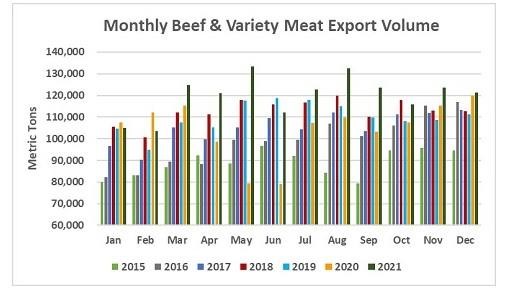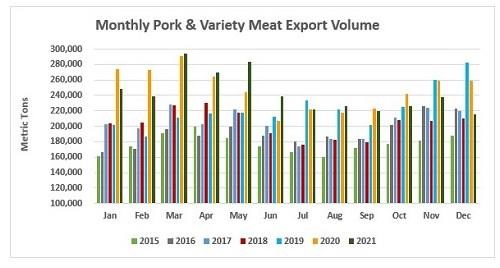U.S. beef exports greatly exceeded previous volume and value records in 2021, surpassing $10 billion for the first time, according to year-end data released by USDA and compiled by the U.S. Meat Export Federation (USMEF). Pork exports finished slightly below the record volume reached in 2020 but set a new value record, topping $8 billion for the first time.
December beef exports totaled 121,429 metric tons (mt), up 1% from a year ago, while value climbed 33% to $991.8 million – the third largest month on record. These results pushed 2021 volume to 1.44 million mt, up 15% from a year ago and 7% above the previous record set in 2018. Export value soared to $10.58 billion, up 38% from 2020 and shattering the previous record (also from 2018) by 27%.
“The beef export results are truly remarkable, especially considering the COVID-related obstacles in the global foodservice sector and all the supply-side and logistical challenges faced by the U.S. industry,” said USMEF President and CEO Dan Halstrom. “Obviously our large Asian markets accounted for much of the growth, but it really takes broad-based global demand to reach these impressive levels. So this success story is not just about Korea, Japan and China – but also a strong performance in Taiwan, excellent growth in Central and South America and a rebound in Mexico and Southeast Asia.”
Pork exports trended lower in December, falling 17% from a year ago to 215,872 mt, valued at $604.3 million (down 12%). For 2021, export volume was 2.92 million mt, down 2% from the 2020 record, but export value still climbed 5% to a record $8.11 billion.
“Entering last year, we knew it would be a daunting task to match the record level of pork exports reached in 2020 because of the recovery in China’s swine herd and its rising domestic pork production,” Halstrom said. “But the U.S. is less dependent on China than other major pork exporters, and this is definitely reflected in the 2021 results. Even with shipments to China falling nearly 30%, total U.S. exports posted a very strong performance thanks to outstanding growth in Latin America and other key markets.”
Beef exports to Korea, Japan and China/Hong Kong each top $2 billion
Japan remained the leading volume destination for U.S. beef exports in 2021 at 320,737 mt, up 5% from 2020 and the second largest of the post-BSE era. Export value climbed 22% to a record $2.376 billion, but finished a close second to South Korea. The U.S. industry remains concerned about Japan’s import safeguard, which resulted in a higher tariff rate being imposed on U.S. beef in late March and early April of last year. Without an adjustment to the safeguard threshold, a similar scenario is possible in 2022 and highly likely in years to come.
Beef exports to Korea totaled 280,143 mt, up 14% and eclipsing the previous record set in 2019. Export value soared 38% to $2.382 billion – not only a record for Korea, but the highest value achieved in any destination. Korea’s surging demand for U.S. beef has been driven largely by growth in the retail sector, both in traditional retail venues and e-commerce platforms. U.S. beef also continues to benefit from the phase-out of Korea’s import duties as the tariff rate under the Korea-U.S. Free Trade Agreement (KORUS) dropped to 10.7% for 2022, down from 40% prior to implementation of the FTA.
Capitalizing on the market access gains included in the U.S.-China Phase One Economic and Trade Agreement, beef exports to China/Hong Kong also broke the $2 billion mark at $2.09 billion, up 114% from 2020, while volume climbed 87% to 240,827 mt. Direct exports to China, which started to gain significant traction in mid-2020, jumped 346% in volume (190,803 mt) and 413% in value ($1.59 billion). U.S. beef accounted for 6% of China’s total imports on a volume basis and 11% by value. Grain-fed beef now accounts for an estimated 11% of China’s imports with the U.S. as the largest supplier, providing approximately 68% of China’s grain-fed imports.
Other 2021 highlights for U.S. beef exports include:
- Though beef exports to Taiwan dipped slightly in volume (63,095 mt, down 1% from 2020), export value climbed to $668 million – up 21% from 2020 and breaking the previous (2019) record by more than $100 million. The U.S. continues to dominate Taiwan’s chilled beef imports, capturing 81% market share in 2021.
- Beef exports to Mexico partially rebounded in 2021, through shipments remained below pre-COVID levels. Exports increased 4% from a year ago to 200,628 mt and climbed 24% in value to $1.06 billion. Mexico is the largest volume destination for beef variety meat exports, which increased 9% to 97,642 mt and jumped 16% in value to $264.1 million.
- Fueled by excellent growth in a range of markets, beef exports to Central America set new records for both volume (20,991 mt, up 52% from a year ago) and value ($137.3 million, up 81%). U.S. beef has a growing presence in the region’s rapidly expanding retail sector and has capitalized on the gradual easing of COVID-related foodservice restrictions. Beef exports to Central America have also benefited greatly from the phase-out of import duties through the Central America-Dominican Republic Free Trade Agreement (CAFTA-DR).
- Beef exports to Colombia surged in 2021, more than doubling year-over-over in both volume (9,359 mt, up 106%) and value ($40.7 million, up 105%) and easily surpassing 2019 records. With shipments also trending higher to Chile and Peru, exports to South America reached 31,802 mt (up 32%) valued at $177.6 million (up 82%). U.S. beef also faces zero duties in these FTA partner countries.
- Led by a sharp rebound in the Dominican Republic, beef exports to the Caribbean increased 31% from a year ago to 25,098 mt, while value climbed 69% to $191.5 million. Exports also increased year-over-year to Jamaica and the Bahamas.
- Exports to Indonesia set new records in 2021, reaching 27,010 mt (up 42%) valued at $118.4 million (up 65%). Indonesia is a key destination for beef variety meat, which accounted for 45% of the total export volume.
- Rebounding from a down year in 2020, global exports of U.S. beef variety meat increased 8% to 300,297 mt and set a new value record, topping $1 billion for the first time ($1.09 billion, up 24%).
- Beef export value per head of fed slaughter equated to a record $407.22 in 2021, up 35% from a year ago. Exports accounted for 15% of total beef production and 12.8% for muscle cuts only, up significantly from the respective 2020 ratios of 13.5% and 11.3%.


Record pork exports to Mexico, CAFTA region, Colombia and the Philippines offset decline in China
Mexico reclaimed its position as the leading volume destination for U.S. pork in 2021, with exports climbing to a record 874,589 mt – up 27% from a year ago and eclipsing the previous (2017) record by 9%. Export value also set a new record at $1.68 billion, up 45% from a year ago and 11% above the 2017 record. While much of the U.S. pork bound for Mexico is for further processing, the U.S. industry has made significant gains in both the retail and foodservice sectors, with pork benefiting from more in-home preparation as well as increased availability through takeout and delivery services.
Led by strong growth in mainstay markets Honduras and Guatemala, as well as larger shipments to Panama, Costa Rica, El Salvador and Nicaragua, pork exports to Central America increased 41% to a record 139,741 mt. Export value was also record-high at $376.1 million, up 56%.
Pork exports to Japan have achieved steady growth since regaining a level tariff playing field at the beginning of 2020 through the U.S.-Japan Trade Agreement. In 2021, exports increased 2% to 394,492 mt, valued at $1.69 billion – up 4% from a year ago and the highest since 2014. The U.S. held the top supplier position for Japan’s chilled pork imports, with volume up 2% to 205,683 mt, valued at $1.02 billion.
Click here to see more...